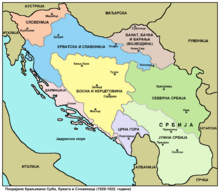You can help expand this article with text translated from the corresponding article in Serbian. (July 2015) Click for important translation instructions.
|
| South SerbiaЈужна Србија Južna Srbija | |||||||||||||
|---|---|---|---|---|---|---|---|---|---|---|---|---|---|
| Pokrajina of the Kingdom of Serbs, Croats and Slovenes | |||||||||||||
| 1919–1922 | |||||||||||||
 South Serbia within Kingdom of Serbs, Croats and Slovenes (in light green) | |||||||||||||
| Capital | Skoplje, Prizren | ||||||||||||
| Population | |||||||||||||
| • 1921 | 1,700,000 | ||||||||||||
| History | |||||||||||||
| • Established | 1919 | ||||||||||||
| • Reorganization | 1922 | ||||||||||||
| |||||||||||||
South Serbia (Serbian: Јужна Србија / Južna Srbija) was a province (pokrajina) of the Kingdom of Serbs, Croats and Slovenes that existed between 1919 and 1922. It encompassed the modern territories of Sandžak (parts of Serbia and Montenegro), Kosovo and North Macedonia. The term "Old Serbia", was historically used in Serbian politics, literature and science for the territories of the province. The term continued in use for the Vardar Banovina and Zeta Banovina following its disestablishment.
History
The province was established in 1919, following the creation of Yugoslavia on 1 December 1918. Serbia had greatly expanded its borders during the Balkan Wars. The province was disestablished in 1922 and its territories were reorganized into the Vardar Banovina and Zeta Banovina. The term was then colloquially used for those territories.
Economy
The province of South Serbia, as a mostly highland region, had favorable conditions for development of cattle breeding as illustrated by statistics on the increase of livestock numbers. The livestock numbers exceeded 13% of the total number of all of Yugoslavia. The restoration of cattle breeding, which had been destroyed during the war years, was the primary goal of the Ministry of Economy.
Demographics
In 1921, the province had c. 1.7 million inhabitants. Following the First World War in Vardar Macedonia and the so called Western Outlands, the local Bulgarian population was not recognized as separate community and became a subject of state-policy of Serbianisation.
References
- Čedomir Popov (2000). Istorija srpske državnosti: Srbija u Jugoslaviji. Srpska akademija nauka i umetnosti. p. 163.
Јужна Србија, која обухвата Вардарску и Зетску бановину
- ^ Institut za noviju istoriju Srbije 2007, p. 170.
- Stojan M. Protić (1921). Vladin predlog ustava: jedna kritika. Pantić i drug. p. 54.
- Poulton, Hugh (2003). "Macedonians and Albanians as Yugoslavs". In Djokić, Dejan (ed.). Yugoslavism: Histories of a Failed Idea, 1918–1992. C. Hurst & Co. Publishers. p. 117. ISBN 9781850656630.
- Papavizas, George C. (2015). Claiming Macedonia: The Struggle for the Heritage, Territory and Name of the Historic Hellenic Land, 1862-2004. McFarland. pp. 92-93, ISBN 9781476610191.
- Horowitz, Shale (2004). "Structural Sources of Post-Communist Market Reform: Economic Structure, Political Culture, and War". International Studies Quarterly. 48 (4): 765. doi:10.1111/j.0020-8833.2004.00324.x.
Sources
- Institut za noviju istoriju Srbije (2007). Srbi i Jugoslavija: država, društvo, politika : zbornik radova. In-t za noviju istoriju Srbije. ISBN 9788670050556.
- Mil R. Gavrilović (1933). Privreda Južne Srbije. "Nemanja" zadužbinska štamparija Vardarske banovine.
- Милослав Стојадиновић (1929). Naše selo. b. i.
- States and territories established in 1919
- States and territories disestablished in 1922
- Pokrajinas of the Kingdom of Serbs, Croats and Slovenes
- Former administrative divisions of Serbia
- Yugoslav Serbia
- Yugoslav Macedonia
- 1919 establishments in Yugoslavia
- 1922 disestablishments in Yugoslavia
- Kingdom of Serbia
- Vardar Macedonia (1918–1941)
- History of Sandžak